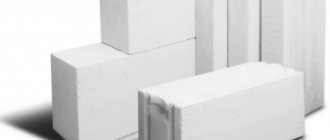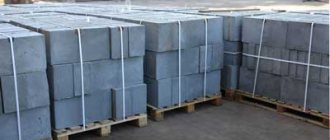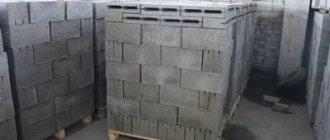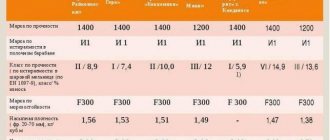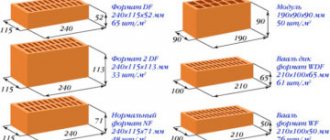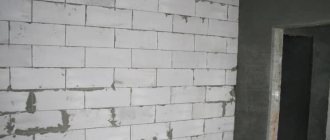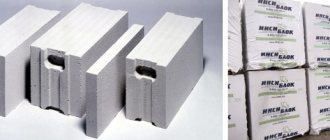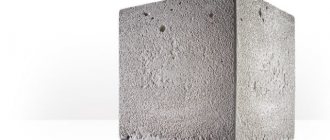When transporting, it is important to know how much a pallet of bricks weighs, because thanks to this you can understand what kind of machine to order. Depending on what clay products will be stacked, the weight of the pallet changes. Nevertheless, GOST establishes both laying rules and the weight of one pallet.
It should not be heavier than 850 kg. And the blocks should be laid flat and “on edge” in cross rows. GOST 3560 defines fastening of a pallet with bricks with metal strips. And GOST 25951 or 10354 allows the use of shrink or stretch film. Bricks are stored, divided by brand and type, laid in 1 tier. It is allowed to stack them in 2 tiers, but no more.
Nevertheless, it is worth considering the fact that not all manufacturers adhere to the standards established by GOST. Sometimes the weight of a pallet of bricks can exceed the norm by up to 4 times. Also, the weight of the pallet may vary depending on the installation method.
What is a pallet?
Pallet (pallet) is a specific device designed for transporting ceramic materials, in particular brick products. It allows you to safely deliver brick blocks to any location with minimal risk of damaging or deteriorating them along the way. Pallets are a special shield made from individual boards. They are:
- Depending on the materials used: wooden;
- metal;
- wood-metal.
- on supports;
With the help of a pallet, not only the transportation of brick products is carried out, but also its storage and loading. In addition, the pallet plays the role of packaging (a kind of pack), and its cost is paid separately by the customer of the building materials. Accordingly, the more expensive the materials from which the container is made, the higher its price. Wooden products are the most popular, since they are the cheapest and, unlike wood and metal products, can be transported by all major modes of transport: water, rail and road.
Despite the unsightly appearance of the pallet, it must be manufactured in compliance with certain standards regulated by GOST. The following rules must be observed:
- full technical equipment of the production line;
- proper manufacturing control;
- compliance with all necessary technical standards and parameters;
- checking the quality of the finished product;
- familiarizing buyers or persons who will use it with the operating rules.
What types of brick packaging are there?
Good packaging and transportation is an important stage of the technological process. It guarantees the safety of the building material. Methods for storing artificial stone and laying it, including on a pallet, can be varied. However, there are the most common ones.
“Herringbone”
Convenient and easiest way to lay bricks on a pallet. As a rule, not only the favorite red brick is packaged this way, but also other types.
The technological feature is that each subsequent row consolidates the previous one.
This method is also convenient for transportation, as it does not require additional packaging material.
Weight of a pallet with bricks
It represents the total mass of both the container and the brick itself. To calculate how much a “clean” building material weighs, you need to know the mass of one and the total number of blocks, multiply these values and subtract the mass of the pallet. The weight must be clarified with the supplier and checked in accordance with GOST, taking into account the type, density, purpose of the block. Solid and single blocks can be transported in 200-400 blocks. Considering that the mass of each is 3.3-3.6 kg, the pallets can weigh either 660 or 1440 kg. The weight of one and a half is less variable, since one block has a mass of 4 kg. No more than 200 bricks can be stacked on one container at a time, and, therefore, the weight is 800 kg.
State building codes state that the weight of a pallet with solid or hollow bricks should not exceed 850 kilograms, but such rules are often ignored by the manufacturer and the mass of material, taking into account the packaging, can exceed one ton or exceed the recommended value by two or more times. According to the requirements, products can be placed on pallets in a herringbone pattern, on an edge, or flat, with the obligatory bandaging of the elements. The same building rules say that pallets with materials can be placed on a construction site no higher than two tiers.
For ease of transportation and preservation of goods, the container is wrapped with a special thick film and tied with metal tape. After production, the bricks are sorted by type and brand and sent to separate areas for storage in the warehouse.
The weight of a pallet with bricks can be found out from the seller or calculated independently, with the exception of products laid out at a certain angle - here the weight indicator may differ. When carrying out independent calculations, you need to have the following information: know the mass of a particular product and their quantity in the pallet.
Mass with brick products of various types
To find out how much a package of bricks weighs, you need to know the total weight of the cargo and container: the minimum weight of one pallet of bricks is 660 kg (single red), and the maximum is 3 tons (silicate).
To make calculations easier, manufacturers often place 1 cube of brick on a pallet, but not everyone uses this technique, so you should be able to determine the weight yourself. There are 2 options for determining the weight of a pallet with brick blocks:
- Independent miscalculation. To do this, you need to know the mass of one unit of material, the total amount that will be located on the pallet and the mass of the container itself.
- Check with the manufacturer or supplier, since the weight does not always meet GOST requirements and may be several times higher than the recommended values.
Usually the wooden pallet itself weighs no more than 30-49 kilograms. And the weight of one brick, depending on the variety, is 1.32–7.2 kg. The table shows calculations of the weight of different bricks on a pallet:
| View | Options | Weight of one brick, kg | Number of bricks on a pallet, pcs. | Weight of a pallet with bricks, kg | |
| Ceramic (red) | Single | Full-bodied | 3,3—3,6 | 200—400 | 660—1440 |
| Hollow | 2,3—2,5 | 350—440 | 810—1110 | ||
| One and a half | Full-bodied | 4—4,3 | 200 | 800—860 | |
| Hollow | 3—3,5 | 280—340 | 865—1150 | ||
| Double | Full-bodied | 6,6—7,2 | 200 | 1320—1440 | |
| Hollow | 4,6—5 | 175—225 | 810—1120 | ||
| Silicate (white) | Single | Full-bodied | 3,7 | 200—380 | 740—1410 |
| Facing (facade) | One and a half | Hollow | 1,32—1,6 | 480 | 634—662 |
How much does a brick weigh?
The weight of the block is variable. It depends on the size and density of the building material, ranging from 2 to 6 kilograms. To find out the net weight of blocks transported on pallets, you need to know what it is. Brick is classified according to several criteria:
- by type - silicate or white, ceramic or red;
- by functional purpose - working, fire-resistant, clinker, facing;
- by size - single, one and a half, double;
- in shape - slotted or dense.
Each type of building structural material has its own purpose, and, therefore, the weight of an individual block is determined at the design stage, taking into account what kind of brick is supposed to be used.
Calculation of the weight of aerated blocks
A large format with a small weight is one of the main advantages of wall materials made of cellular concrete, which makes it possible to speed up construction time and avoid the need for lifting mechanisms in the process of laying walls. When calculating the loads on the foundation, and when organizing delivery, you need to know how much the gas block weighs. What it depends on, how it is determined and how it is interconnected with other characteristics will be discussed below.
How are building materials placed on a pallet?
Placing brick blocks on pallets is done in several ways approved by GOST. The height of the bricks in the package is also regulated and should not exceed 1 m. At the same time, the types of briquettes do not affect the laying method; the same technologies are used to place backfill, refractory, oven and other types. Methods for arranging ceramic products on a pallet:
- Bandaging rows. Brick blocks are laid on the board edgewise or flat, depending on the types, sizes, and methods of transportation. After this, they are secured using horizontal cross-knitting.
- "Herringbone". This is the safest way to lay brick briquettes. It consists of placing the transported products at a strictly 45º angle to the center, and they are fixed at the edges of the pallet with triangular bars. Using this method allows you to transport building materials without scattering or compromising its integrity.
A brick package can fit a certain number of blocks, which depends on the type, weight, size and presence of voids in the material. There are varieties of ordinary, cinder block, stove, Karasevsky, backfilling, ordinary (M 150) material from which brickwork is made. They are used in the construction of load-bearing walls, interior partitions, the construction of stairs, fences, as well as in the construction of basements.
Packaging Features
Transport packaging for bricks is called a pallet, which is translated from French as pallet. Note that in construction both designations are allowed - pallet and pallet.
Of course, it is better to use a more durable sample, but its cost will be slightly higher. Meanwhile, according to the instructions, the pallet should not have such defects as:
- through gaps present at the supporting joints;
- diagonal deviation exceeds 1 cm;
- defects in the components of the flooring due to flatness exceeding 5 mm.
Number of bricks in one pallet
Despite the abundance of fundamentally new building materials, traditional brick still remains one of the most popular and relevant options for laying walls and building individual houses. Bricks are sold in pallets, which greatly facilitates their storage, transportation and loading. But most private developers prefer to calculate the volume of purchases individually. In addition, quite often manufacturers set the price not per unit of goods, but per pallet. Therefore, in order to know the full cost, it is necessary to correctly calculate how many bricks are in the pallet.
Brick and its varieties
In order to calculate the amount of material that fits in one pallet, you should understand which type of material needs to be purchased in a particular case. Depending on the raw materials used, silicate and red bricks are distinguished. According to its structure, it is:
Red.
Red brick is predominantly used in the construction of houses and cottages. It is made from various types of clay by firing. It is quite durable, not too heavy (solid weighs approximately 3.6 kg, hollow - 2.5 kg) and successfully withstands harmful atmospheric influences. The standard size is 250 x 120 x 65 mm.
No less popular is silicate briquette, which is produced by autoclave from sand with various additives. This type has excellent heat and sound insulation properties, as well as high frost resistance. The weight of the product is slightly larger - a solid one weighs 5 kg, a hollow one - no more than 4.
Number of blocks in a pallet
The capacity of the platform depends on the size of the bricks laid on it, as well as on the dimensions of the platform itself. There are single, one and a half and double bricks. In all cases, the dimensions of the product remain unchanged, only the height differs:
- for single – 6.5 cm;
- for one and a half – 8.8;
- for double – 10.3.
As for pallets, they come in two types:
- standard – 103 x 52 cm, load capacity – 750 kg;
- reinforced – 103 x 77 cm, load capacity – 900 kg.
Knowing the weight of the material, as well as its main parameters, you can calculate how many pieces the platform can hold. To do this, the area of the base is divided by the area of one product. By multiplying the resulting number by the number of rows on the pallet, we find the total amount:
- no more than 420 pieces if it is a single brick;
- about 390 units if it is one and a half;
- up to 200 doubles.
Such calculations will not be suitable if the installation on the base took place at an angle of 45 degrees - “herringbone”. In this case, you can find out the number of blocks using simple geometry, namely by counting in one cubic meter.
The information obtained allows you to optimize costs. The price of wall material, which makes up a significant share of the total cost of building a house, does not allow you to buy it “just in case.” In addition, excessive quantities will increase the cost of transport and loading.
Pricing is influenced by the following points:
1. brand and country of origin;
2. technical characteristics and dimensions;
3. strength and ability to withstand many freezing cycles;
4. distance from the construction site.
Characteristics of the ceramic product
It is obtained from clay, so it can be classified as an environmentally friendly material. In addition, the product has excellent strength characteristics, thanks to which a structure built from brick can withstand loads and mechanical influence.
You can find out what white silicate brick looks like in this article.
Strength is marked “M”, followed by numbers in the formula. It is the numerical designation that indicates the degree of load per 1 m2. On the construction market, solid red brick can be found with the following markings: M-75 - M-300. The higher the numerical designation, the higher the strength characteristics of the product in question.
Natural material can withstand frequent freezing and thawing. At the same time, it cannot be deformed, and there are no cracks on its surface. Thanks to this positive characteristic, it is possible to use the product in the construction of houses in different climatic regions.
How much a solid red brick weighs can be found in this article.
The next positive characteristic is thermal conductivity. This quality indicator determines the ability to store thermal energy in a room. However, if you compare a solid brick with a hollow one, it is slightly inferior in this quality.
The main advantage of solid ceramic brick remains its ability not to lose all its qualities over a long period of use, despite the fact that it has already been used previously. The size in question, 250x120x65 mm, is standard, making it possible to lay walls of various thicknesses. The versatility of the dimensions lies in the fact that one length will be equal to two widths and four heights. To bind bricks, it is necessary to use vertical and horizontal rows during laying.
What sizes of red ceramic bricks can be found in this article.
Standard weight
In addition to the previously described characteristics, it is necessary to consider the weight of solid bricks. How much does it weigh?
For a size of 250x120x65 mm the weight will be 3.510 kg. Compared to hollow ones, this indicator is slightly higher, however, the strength and reliability in this case are higher.
What is the weight of sand-lime brick can be found in this article.
Types of bricks
In order to choose the right brick for various types of masonry, you need to know its technical characteristics and purpose. All currently produced products can be classified according to the following criteria:
- the raw materials used;
- purpose;
- the nature of the filling;
- appearance and size.
In addition, various production technologies and molding techniques can be used to produce a ceramic product.
Classification of bricks according to the type of raw materials used
The performance characteristics, purpose and service life of the product depend on the material of manufacture.
Ceramic
This type of brick is made from high-quality clay, free of sulfates and marl. At the first stage of the technological process, molding occurs. After drying, the workpieces are placed in special ovens, where they are fired at a temperature of 10,000C. A quality product is characterized by a semi-matte surface and a porous structure.
Silicate
The main ingredient included in the product is purified quartz sand. In addition, up to 10% lime is added to the working mixture. This material can be used to build both load-bearing walls and internal partitions.
Hyper-pressed
The raw material for such bricks is screening of marble, limestone, dolomite or shell rock; their share in the working mixture accounts for up to 90%. Portland cement is used as a binder, the mass part of which can be from 6 to 8%. The resulting mixture is poured into special molds and compressed. On the building materials market you can find smooth and textured hyper-pressed bricks. Both modifications are widely used for cladding buildings.
Classification by purpose
The scope of application of a particular type of material depends on its technical characteristics and operating conditions.
Construction (private)
The technical characteristics of building bricks are regulated by GOST 530-2007. Area of application: construction of load-bearing walls and partitions. Since the appearance and thermal insulation properties leave much to be desired, the facade is additionally insulated with mineral materials and decorative cladding panels are attached.
Facing
The main features are high surface quality and minimal deviations in size and shape. When decoratively cladding a facade, two types of cladding materials can be used.
Textured facing
The product can be produced with both smooth and textured edges. Textured brick is used for decorative cladding of facades and the construction of permanent fences.
Shaped facing
Such a product is specially manufactured for cladding decorative elements (arches, columns, window slopes, etc.) and can have a wide variety of configurations. Only top-class professionals can provide high-quality styling.
Chamotte
The main distinguishing feature of fireclay (kiln) brick is its high heat resistance and minimal thermal conductivity. Used for laying stoves, fireplaces and other fireproof structures. High-quality fireclay products can withstand temperatures up to 10,000C for a long time.
Clinker
This variety is obtained by sintering refractory layers of clay. The clay used is thoroughly cleaned from impurities of chalk, alkali metal salts and other impurities. Clinker brick is characterized by high strength and hardness, practically does not absorb moisture and does not lose its properties in the temperature range from +50 to -500C.
Its use as a facing material provides reliable protection of the facade from atmospheric influences and mechanical damage.
Classification by filling
Depending on the purpose of the building, a solid or hollow type can be used.
Full-bodied
This variety does not have any voids and is a monolithic parallelepiped. Used for laying load-bearing walls of buildings.
Hollow
The mechanical strength of such a material is significantly lower than that of a monolithic one, but it has lower thermal conductivity. In sand-lime brick, voids can range from 25 to 30% of the volume of the product. Most often, hollow bricks are used for cladding and the construction of internal partitions.
Classification by size
In order to correctly calculate the amount of brick, you need to know its overall dimensions. There are three main sizes.
| Brick size | Overall dimensions, mm |
| Single | 250x120x65 |
| One and a half | 250x120x88 |
| Double | 250x120x138 |
GOST 18343-80. Pallets for bricks and ceramic stones. Technical conditions.
And the pallets themselves are prohibited from being placed higher than 2 tiers. Violation of the acceptable methodology for laying brick blocks on a pallet causes an increase in their total mass. Share with your friends:.
Pallets allow you to avoid this. The laying method is determined by the type of blocks being transported. Solid bricks are usually folded in a herringbone pattern, while hollow bricks are folded in a cross-link pattern.
Number of single bricks on a pallet
Correct calculation of the required amount of material for any building allows not only to complete the construction in a timely manner and without delays, but also to save the owner’s money.
If the brick calculation is incorrect, the shortfall will have to be compensated by a new purchase, and the excess will have to be sold for 50% of the cost
Therefore, it is important to consider all options for construction work before purchasing material.
Heavy building materials, such as bricks, are stored and warehoused, transported and transported using pallets. The materials are secured to the shipping pallet using special fastening belts. A special shrink film is also used to pack bricks onto pallets.
Pallets are transported by electric vehicle, so shipping containers are divided into two types. The first type of pallet is designed for transportation by electric vehicle by hooking the container with a double fork, and the second type is designed for transportation on four sides.
Plastic, metal, and wood are used to produce pallets, so they have disposable and reusable service life. The weight of one transport container is 16–22 kg, and allows you to transport over 1 ton. cargo
The size of reusable pallets is calculated taking into account transport trucks and their internal dimensions. Therefore, the dimensions of the container correspond to international standards, and a regular wooden pallet has a size of 0.8x1.200x0.145 m. The sizes of Finnish pallets differ slightly: 1x1.2x0.145 m.
Type of bricks and their capacity per pallet
Depending on production, bricks are divided into silicate and ceramic, solid or hollow inside.
The variety of brick sizes depends on its dimensions: single, one-and-a-half, double.
The parameters of ordinary brick are 250x120x65, which is very convenient for construction.
- Construction bricks are used to build walls.
- For the outer part of the walls, facing bricks are used.
- For stove masonry, special fireclay bricks are used that can withstand high temperatures.
Load capacity of pallets
The maximum permissible load capacity of a pallet with parameters 1030x520 mm is 750 kg, for a pallet 1030x770 - 900 kg, and for a pallet 1200x800 - 1500 kg. When calculating the required amount of building material, not only the load-carrying capacity of the pallet is used, but also the order in which the bricks are laid on it.
When laying in regular rows, counting is simple. We multiply the number of rows by the number of bricks in it. But if the installation was done at an angle of 45, that is, in a herringbone pattern, the calculations will be much more complicated.
Number of red bricks on a pallet
The weight of one solid red brick is 3.5 kg, and that of a hollow one is 2.4 kg. Knowing the possible options for loading platforms of a brick manufacturer, it is easy to calculate the number of bricks on a pallet.
The dimensions of the ceramic brick correspond to 0.25x0.12x0.065 m. This means that 480 pieces can be placed on a pallet. solid brick and 309 pcs. with voids inside.
How many sand-lime bricks on a pallet
The weight of solid silicate building brick is 5 kg, and with voids 4 kg. Therefore, 1 pallet can accommodate 325 pieces of solid and 240 pieces. hollow sand-lime brick.
Number of facing bricks on a pallet
Its size is 0.25x0.09x0.005 m. Since laying on a pallet higher than 1 meter is not carried out, during normal laying 360 pieces of facing bricks are placed on the stand.
Number of single, one and a half and double bricks
To calculate the quantity, you need to know the area of the cargo stand and the area of the brick.
By dividing the area of the stand by the area of the brick, we get the amount of building material placed on one stand. We multiply by the number of stands and get the number of bricks on the pallet.
You can just remember that a standard pallet holds 420 pieces of single brick, 390 pieces. one and a half and 200 pcs. double.
Interesting articles:
- DIY brick gazebo with barbecue, options
- Country luxury: how to make a brick tandoor with your own hands and enjoy delicious dishes
- Two-story brick house: what you need to know before starting construction
- Brick fence reliability and protection
- Do-it-yourself fence made of corrugated board and brick
- How to use old bricks in your dacha
Density
The extrusion method is one of the most common methods used in the manufacture of ceramic stones. It is only thanks to this production method that the products are so strong and dense. The density of hollow bricks depends on the selected raw material and its composition, and the type of voids will also affect the density.
The density indicator is also influenced by the purpose of the ceramic building material:
- density of facing brick stone from 1300 to 1450 kg/m³;
- the density of ordinary ordinary brick stone is from 1000 to 1400 kg/m³.
How many pallets fit in a truck, KamAZ, long length
If you need to load bricks into a long length, and the pallet size is, say, 1130x520, then their number will be 32. If loading is carried out in KamAZ, then with euro-sized pallets their number will be 10-12 pieces. When transporting material in a truck, their number reaches 32-33.
Brick is a very popular building material, which today is actively used for various purposes. But today the process of transporting this product occurs in special pallets. Thanks to them, it is possible to ensure simplicity and ease of transportation. In addition, this facilitates the process of recalculation for the seller, which is carried out by the sale of the specified product. Choose only high-quality products, and then your building will serve you for a long time.
- Terrace board - a practical material for steps and porches
- How and at what temperature can bricks be laid?
- Primer "Betonokontakt" Knauf: properties and technical characteristics
Discussion 2 comments
Brick has long been valued as a reliable building material. Our grandfathers also built houses from bricks and they were always strong and you could live in them for decades. Now, of course, bricks are made from a different material, but the basis is the same. Personally, to build my house, I ordered four pallets of red bricks. Although the house took a long time to rise, I am very pleased that I chose this particular material.
When we built a house, they sold us bricks only by the full pallet. So at least they are not damaged during transportation. Unfortunately, the factory does not report the bricks; just for fun, they counted and always missed about 30-35 bricks - that’s a lot. One pallet arrived broken, so it’s worth choosing a quality manufacturer, now we doubt the quality of the brick itself.
State building codes state that the weight of a pallet with solid or hollow bricks should not exceed 850 kilograms, but such rules are often ignored by the manufacturer and the mass of material, taking into account the packaging, can exceed one ton or exceed the recommended value by two or more times. According to the requirements, products can be placed on pallets in a herringbone pattern, on an edge, or flat, with the obligatory bandaging of the elements. The same building rules say that pallets with materials can be placed on a construction site no higher than two tiers.
For ease of transportation and preservation of goods, the container is wrapped with a special thick film and tied with metal tape. After production, the bricks are sorted by type and brand and sent to separate areas for storage in the warehouse.
The weight of a pallet with bricks can be found out from the seller or calculated independently, with the exception of products laid out at a certain angle - here the weight indicator may differ. When carrying out independent calculations, you need to have the following information: know the mass of a particular product and their quantity in the pallet.
Important Factors
The type of paving slabs determines how many paving stones can fit per unit of shipping container. Standard types of stoves have similar weight and capacity. For example:
- The “Old Town” tile has dimensions of 180x120x60 and a weight of 127 kg per 1 m². One pallet will hold 12.5 m², and the total weight will be 1620 kg.
- The “Brick” tile has dimensions of 200x100x60. But, the pallet will have the weight and capacity of the “Old City” tiles.
- “8 bricks” paving stones with dimensions 300x300x30 have a mass of 60 kg per 1 m², 10.8 m² fits in a pallet. A full container will weigh 660 kg.
Please remember that these estimates are approximate. It all depends on the choice of paving stone type, its weight, size and thickness. Before placing an order, check with your consultant how many paving stones will fit in one pallet. This information is available in open form in manufacturers’ online stores.
How many bricks are in a pallet, size of facing and standard
In order to deliver brick blocks to a construction site with minimal transportation costs and not miscalculate when purchasing, you should know how many bricks are in a pallet and how many such packages you need to purchase, and what transport to order. At the same time, it is easier to compare prices from different manufacturers (they are often set on a per-pallet basis) and determine the total costs.
Types of brick packaging
For ease of shipment and transportation, brick products are placed on wooden boards (pallets) made of boards connected by bars.
- small – 0.52 x 1.03 m, load capacity up to 0.75 t;
- large – 0.77 x 1.03, holds up to 0.9 tons of cargo.
Often the manufacturer indicates the number of bricks, but there are also options when he does not do this. The approximate number of products on a pallet can be easily determined by calculation. To do this, the area of the shield is divided by the area of the base of one product - this is how the number of products in the first layer is obtained. Then multiply the result by the number of rows in the purchased package.
Pallet stacking norm
How many brick products on a large pallet:
- single (standard brick size 250 x 120 x 65 mm) - about 420 pieces;
- one and a half (250 x 120 x 88 mm) - approximately 390 pieces;
- double (250 x 120 x 138 mm) – about 200 pieces;
- double corrugated – 192 pieces;
- tortoiseshell M150 – 280 pieces;
- with torn edge (single) – 308 pieces;
- with a torn edge (angular) - 352 pieces;
- basement - 478 pieces.
How much does a pallet of bricks weigh?
It is important to know the answer to this question when ordering a vehicle with a certain carrying capacity - the number of trips and payment for transport depend on the weight of one loaded pallet. For reference, below is information about the mass of one brick block
- Weight of 1 piece of solid sand-lime brick:
- single – 3.7 kg;
- one and a half – 5.0 kg.
- Hollow brick weight:
- one and a half – 4.0 kg;
- double – 5.2 kg.
- Ceramic products have less mass:
- single hollow – 2.6 kg;
- single full-bodied – 3.6 kg;
- shortened – 2.1 kg.
Thus, you can calculate how much, for example, a small pallet of single bricks weighs: 275 x 3.7 = 1017 kg. If we add the tare weight (15 kg), then the gross weight is 1032 kg.
How many cubes of material need to be purchased
- The first step is to calculate the total volume of brick walls with mortar, taking into account their wall sizes and quantity, as well as the type of masonry. Multiply the height, length and width, and then sum up the volumes.
- Usually, when planning construction, they calculate how many bricks are in a masonry cube. In this case, be sure to discard the volume of masonry mortar (1.5 cm). For example, if the size of a one-and-a-half brick is 250 x 120 x 88 mm, then its volume is 0.00264 m3, and together with the mortar - 0.00327 m3. Based on this, the masonry cube contains 306 one-and-a-half blocks. You can take ready-made table values.
- The next number you need to know is how many bricks are in a pallet in cubic meters? You will need the volume of the product without solution. For a one-and-a-half brick, the result is already ready - 0.00264 m3; single – 0.00195 m3; double – 0.00414 m3. Next, we multiply the number of brick blocks in the container by the volume of one block. For example, the cubic capacity of a single brick on a large pallet: 420 x 0.00195 = 0.82 m3.
It remains to find out the number of packages - to do this, divide the need for bricks in cubes by a number indicating how many bricks are in a pallet per m3.
Average price of one pack per cubic meter
In most cases, the price for bricks is set by the seller per piece, and not per pallet.
Table 1 - Cost of various types
| Variety | Quantity per pallet, | Price, rubles |
| Hollow ceramic face – silicate | 420–480 | 8 600 – 9 300 |
| 308–352 | 5 900 – 7 400 | |
| 400–440 | 4 900 – 5 600 | |
| 334–380 | 5 100 – 5 900 | |
| Solid ceramic ordinary-silicate | 330–400 | 5 120 – 5 800 |
| 240–380 | 3 300 – 4 600 | |
| 224–360 | 3 600 – 5 600 | |
| 400–436 | 3 300 – 3 600 | |
| 280–340 | 3 100 – 3 700 | |
| 200–240 | 3 400 – 4 100 | |
| Torn (corrugated) | 307–436 | 5 200 – 6 500 |
| Special, fireproof | 330–360 | 11 200 – 12 200 |
